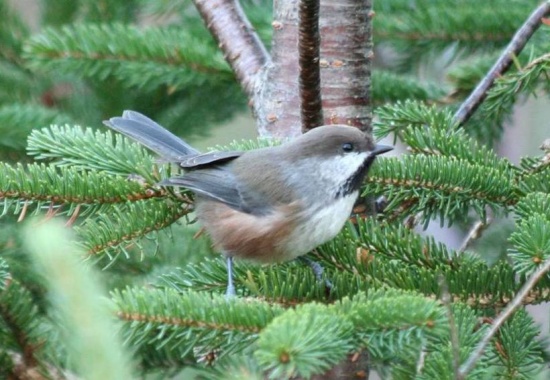JohnN-1520 (talk | contribs) |
|||
| (13 intermediate revisions by 5 users not shown) | |||
| Line 1: | Line 1: | ||
| − | + | [[Image:Boreal_Chickadee.jpg|thumb|550px|right|Photo by {{user|lwr|lwr}}<br />Whitbourne, [[Newfoundland]], November 2005]] | |
| − | [[Image:Boreal_Chickadee.jpg|thumb|550px|right|Photo by lwr]] | + | ;[[:Category:Poecile|Poecile]] hudsonicus |
| − | |||
| − | |||
==Identification== | ==Identification== | ||
| − | + | 12.5–14.5 cm | |
| + | *Grey-brown upperparts | ||
| + | *Brown cap | ||
| + | *Greyish wings and tail | ||
| + | *Grey face with white sides | ||
| + | *White underparts | ||
| + | *Brown flanks | ||
| + | *Black throat | ||
| + | *Short dark bill | ||
| + | *Short wings | ||
| + | *Long notched tail | ||
| + | ==Distribution== | ||
| + | In most boreal regions of [[North America]], meaning the coniferous forests of Canada, Alaska and northernmost parts of some US states such as Maine and Minnesota. Additional "islands" of habitat in the fir forests on mountain ranges in New York and New England. | ||
| + | |||
| + | ==Taxonomy== | ||
| + | This is a [[Dictionary_P-S#P|polytypic]] species, consisting of five subspecies<sup>[[#References|[1]]]</sup>: | ||
| + | *''P. h. stoneyi'': | ||
| + | :*Northern [[Alaska]] to northern [[Yukon]] and north-western Mackenzie | ||
| + | *''P. h. hudsonicus'': | ||
| + | :*Central [[Alaska]] and Yukon to [[Minnesota]], [[Labrador]] and [[Newfoundland]] | ||
| + | *''P. h. columbianus'': | ||
| + | :*Southern Alaska to southern Yukon, [[British Columbia]], [[Montana]] and [[Washington]] | ||
| + | *''P. h. farleyi'': | ||
| + | :*North-eastern British Columbia and [[Alberta]] to [[Saskatchewan]] and [[Manitoba]] | ||
| + | *''P. h. littoralis'': | ||
| + | :*South-eastern [[Canada]] (southern Quebec) to [[Nova Scotia]] and north-eastern [[US]] | ||
| + | |||
| + | The scientific name of this species has in the past been given as both ''[[:Category:Parus|Parus]] hudsonicus'' and ''Poecile hudsonica'' but most world wide checklists currently use ''Poecile hudsonicus''. | ||
| + | |||
| + | ==Habitat== | ||
| + | Dense coniferous woodland, especially spruce and fir. | ||
| + | |||
| + | ==Behaviour== | ||
| + | ====Breeding==== | ||
| + | Monogomous. They nest in a tree hole which both sexes excavate. | ||
| + | ====Diet==== | ||
| + | The diet includes aphids, moths, insect larvae and conifer seeds. | ||
| + | |||
| + | ====Vocalisation==== | ||
| + | '''Call''': ''tsik-a-dee-dee''. | ||
| + | |||
| + | (Similar to the call of a black-capped chickadee, but usually described as less melodious.) | ||
| + | |||
| + | ==References== | ||
| + | #{{Ref-Clements6thAug13}}#Handbook of the Birds of the World Alive (retrieved April 2014) | ||
| + | #Wikipedia | ||
| + | {{ref}} | ||
==External Links== | ==External Links== | ||
| − | {{GSearch|Poecile+ | + | {{GSearch|Poecile+hudsonic*}} |
| − | [[Category:Birds]] | + | <br /> |
| + | {{Video|Boreal_Chickadee}} | ||
| + | |||
| + | [[Category:Birds]][[Category:Poecile]] | ||
Latest revision as of 21:22, 2 August 2021
- Poecile hudsonicus
Identification
12.5–14.5 cm
- Grey-brown upperparts
- Brown cap
- Greyish wings and tail
- Grey face with white sides
- White underparts
- Brown flanks
- Black throat
- Short dark bill
- Short wings
- Long notched tail
Distribution
In most boreal regions of North America, meaning the coniferous forests of Canada, Alaska and northernmost parts of some US states such as Maine and Minnesota. Additional "islands" of habitat in the fir forests on mountain ranges in New York and New England.
Taxonomy
This is a polytypic species, consisting of five subspecies[1]:
- P. h. stoneyi:
- P. h. hudsonicus:
- Central Alaska and Yukon to Minnesota, Labrador and Newfoundland
- P. h. columbianus:
- Southern Alaska to southern Yukon, British Columbia, Montana and Washington
- P. h. farleyi:
- North-eastern British Columbia and Alberta to Saskatchewan and Manitoba
- P. h. littoralis:
- South-eastern Canada (southern Quebec) to Nova Scotia and north-eastern US
The scientific name of this species has in the past been given as both Parus hudsonicus and Poecile hudsonica but most world wide checklists currently use Poecile hudsonicus.
Habitat
Dense coniferous woodland, especially spruce and fir.
Behaviour
Breeding
Monogomous. They nest in a tree hole which both sexes excavate.
Diet
The diet includes aphids, moths, insect larvae and conifer seeds.
Vocalisation
Call: tsik-a-dee-dee.
(Similar to the call of a black-capped chickadee, but usually described as less melodious.)
References
- Clements, J. F., T. S. Schulenberg, M. J. Iliff, B.L. Sullivan, C. L. Wood, and D. Roberson. 2013. The eBird/Clements checklist of birds of the world: Version 6.8., with updates to August 2013. Downloaded from http://www.birds.cornell.edu/clementschecklist/download/
- Handbook of the Birds of the World Alive (retrieved April 2014)
- Wikipedia
Recommended Citation
- BirdForum Opus contributors. (2024) Boreal Chickadee. In: BirdForum, the forum for wild birds and birding. Retrieved 1 November 2024 from https://www.birdforum.net/opus/Boreal_Chickadee
External Links




